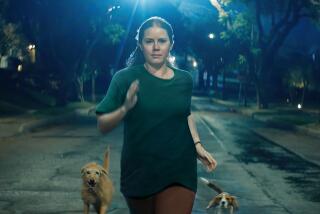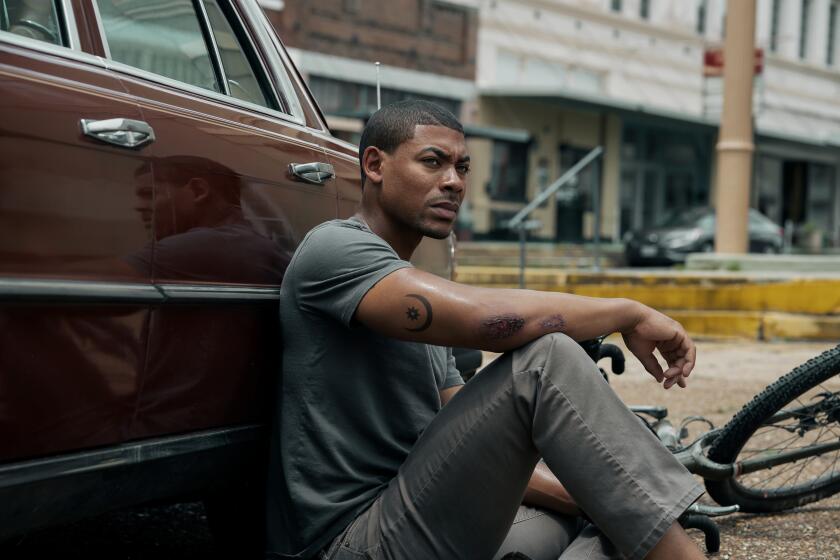Video: Alex Garland, Rian Johnson, Graham Moore talk ‘Ex Machina’

<p>Alex Garland chats with “Looper” director Rian Johnson.</p>
“Ex Machina,” which writer-director Alex Garland recently referred to as “a sci-fi psychological thriller,” has undoubtedly been one of the bright spots of the spring movie season.
Having received largely positive reviews -- Times critic Kenneth Turan called it “a spooky piece of speculative fiction that’s completely plausible, capable of both thinking big thoughts and providing pulp thrills” -- the film earned the best limited opening so far this year two weeks ago and opens nationally this weekend.
Last weekend, Garland appeared in a Los Angeles theater for a pair of post-screening Q&As. Moderating one was Graham Moore, Oscar-winning screenwriter of “The Imitation Game,” while the other was moderated by Rian Johnson, writer-director of “Looper” and an upcoming episode of the revitalized “Star Wars” saga.
“This is an ideas movie,” Garland said, while speaking to Moore. “It’s an old-fashioned sci-fi movie in that respect. It proposes questions. Some of the questions it offers an answer, some of them it doesn’t.”
The movie deals, in a sense, with nothing less than what makes a human a human. A mid-level employee at a tech company, Caleb (Domhnall Gleeson), is summoned to the remote estate of the company’s reclusive founder Nathan (Oscar Isaac). Once there Caleb meets Ava (Alicia Vikander), an artificially intelligent robot that Nathan has designed and built in secret. The three of them then become locked into a test of wits and wills, with allegiances and understanding shifting.
The film is marked by surprising and nuanced performances by its three leads and by stunning, seamless visual effects work used to created Ava.
Johnson alluded to his upcoming project while asking a question about how the sleek effects used to create Ava when he said, “In something like the film that I made, ‘Looper,’ or in ‘Star Wars,’ you can kind of just take an old engine part and stick something different on it and call that your tech, where you’re actually having to figure out, with a limited budget, how to create an A.I. brain.”
Garland noted it was a multi-step process, “with a step back that this is a post-iPhone world and people are used to tech being beautifully designed.”
He added that the initial process had to do with making sure it looked unlike robots from other movies, so gold was out for looking like C-3PO from “Star Wars,” white plastic for a well-known Bjork video and then also the robot design in the classic “Metropolis.”
“So when she first appears you don’t want to be initially thinking of another movies,” Garland said. “She had to unambiguously be a machine, so it didn’t give raise in the narrative the possibility that it might be a young woman in a robot suit.
“More important than that for me, the breakthrough aspect was this mesh, that covers the contours of Alicia Vikander’s body,” he added. “So you immediately see her as a machine and then you immediately start to move away from that.”
Johnson complimented Garland on the choice to see Vikander’s real hands and feet, to which Garland quickly responded, “that was budget. Imagine building a CG hand, it’s a … nightmare.”
Garland also spoke about the film’s use of misdirection to keep audiences engaged when he said, “Some people just want a story, they’ll just accept whatever comes and others, their antennae are up, and they’re hunting, they want to get ahead of it in some way. And I felt pretty sure there were two key misdirections we could do that would take attention away from some of the other stuff we wanted to keep covert.
“The intention was that the antennae twitching audience would then relax and go, “I get this,’” Garland said. “Because I think the ideal state is just to let the thing happen.”
A question from the audience asked about the behavior of Ava the robot within the context of whether or not Garland himself is scared of artificial intelligence.
“The conniving you talk about is resource from my perspective. It’s being resourceful. So it really is a question of perspective and where you ally yourself,” Garland said.
“So I’m going to sort of disagree in a holistic way with everything about the question,” he said, “but that’s your take, on the 50-50 contract deal between the story that’s given and the story that’s interpreted, that’s legit. It’s yours, it’s just not mine.”
Johnson complimented the film by saying, “Ultimately it does that magic trick which my favorite movies all do, which is that it does exactly what it told you it was going to do and you’re surprised by it at the end.”
The conversation after an earlier showing with Moore was also of interest, and perhaps not surprisingly focused more specifically on the writing. Moore asked of the initial inspiration for the story.
“I’m a writer by trade and I love sci-fi,” said Garland. “And sci-fi gives you room to talk about stuff like consciousness and Artificial Intelligence in a sort of unembarrassed way. There was something about the way strong A.I. and human consciousness did inform each other, relate to each other. You could make a film about a robot and make the film about us.”
Later Garland explained his position regarding Ava and artificial intelligence by saying, “Sentience plus empathy, I’m on her side.”
Follow on Twitter: @IndieFocus
More to Read
Only good movies
Get the Indie Focus newsletter, Mark Olsen's weekly guide to the world of cinema.
You may occasionally receive promotional content from the Los Angeles Times.









